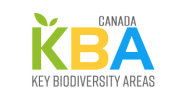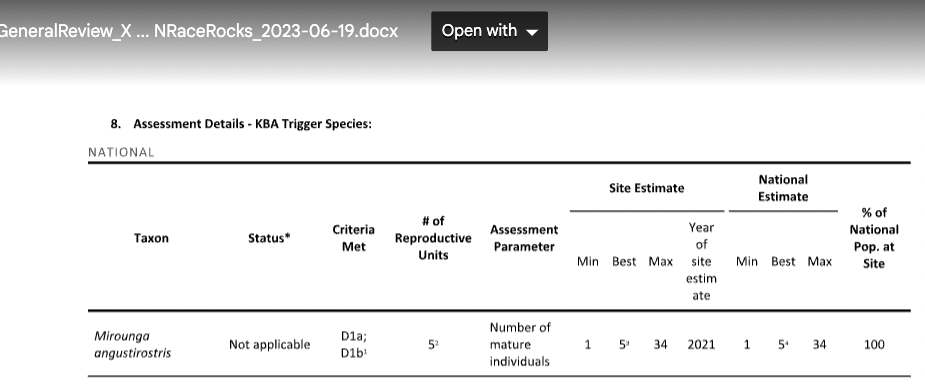 In June 2023 Ian Adams presented for the Annual General Meeting of Friends of Ecological Reserves on the Key Biodiversity Areas program in Canada. This presentation is available here: https://ecoreserves.bc.ca/2023/06/07/key-biodiversity-areas-ian-adams-fer-agm-june-2023/
In June 2023 Ian Adams presented for the Annual General Meeting of Friends of Ecological Reserves on the Key Biodiversity Areas program in Canada. This presentation is available here: https://ecoreserves.bc.ca/2023/06/07/key-biodiversity-areas-ian-adams-fer-agm-june-2023/
The website of KBA Canada is here: https://gis.natureserve.ca/portal/apps/dashboards/8a89d50ea0b04c7790e19791ab9ae6e8
Race Rocks Ecological Reserve is on the list of proposed KBAs in British Columbia along with several other Ecological Reserves in the province .
See the pdf: KBASummary_GeneralReview_XwaYeNRaceRocks_2023-06-19 KBASummary_GeneralReview_XwaYeNRaceRocks_2023-06-19
Below is a copy of that document.:
XwaYeN (Race Rocks) KBA, British Columbia
Northern Elephant Seal (Mirounga angustirostris)
Instructions for Reviewers
1. Read through the “Summary of Proposed KBA” section.
2. Answer the survey questions in the Online Review App.
3. For additional information, see:
What are KBAs and how are they assessed?
Instructions for reviewers
Summary of Proposed KBA
Please note that this summary was generated automatically, and as a result there may be species scientific names that are not italicized.
KBA Name: XwaYeN (Race Rocks)
Location (province or territory [mid-point lat/long]): British Columbia [48.297 /-123.53]
KBA Scope: National
Proposal Development Lead: Ian Adams
1.
5. Trigger Biodiversity Element(s):
● Species: Northern Elephant Seal (Mirounga angustirostris)
6. Site Status Summary:
XwaYeN (Race Rocks)
is a candidate National
KBA for the following KBA criteria:
● National D1a [criterion met by 1 taxon] – Site predictably holds an aggregation representing ≥1% of the national population size of a taxon,
over a season, and during one or more key stages of its life cycle (Mirounga angustirostris).
● National D1b [criterion met by 1 taxon] – Site predictably holds a number of mature individuals that ranks the site among the largest 10
aggregations known for the taxon in the country (Mirounga angustirostris).
7. Site Description:
The XwaYeN (Race Rocks) KBA overlaps with Race Rocks Ecological Reserve, which was created to protect intertidal and subtidal communities
that are extremely rich as a result of strong tidal currents. Energy and nutrient inputs attributable to the nearly continuous currents are large,
and light penetration in these shallow, clear waters is excellent. These factors result in a high production of algae and invertebrates, while the
varied topography promotes ecological diversity. Consequently, the marine communities here are unusually luxuriant and rich. XwaYeN is in the
Coastal Douglas-fir Moist Maritime biogeoclimatic zone (BC Parks 2022), though none of the islands are forested.

1 Meets criterion D1b because it is one of 10 largest aggregations in Canada for this taxon.
2 Composition of 10 Reproductive Units (RUs): Elephant seals are polygynous so 10 RUs is 10 adults females and 1 adult male. . Source of RU
data: IUCN 2016; Fletcher 2016; Race Rocks Ecoguardians 2022.
3 Derivation of site estimate: Other. Explanation of site estimate(s): Five Elephant seal pups were born at the site in 2021 (Race Rock
Ecoguardians 2022; BCCDC 2022). Race Rock Ecoguardian observation data collated for 1 Jan 2014 through 20 Jan 2016 found almost continual
presence of Northern Elephant Seal at Race Rocks. Counts range from 1 to 34 individuals, including all age classes: adults, sub-adults and pups.
A best estimate of 5 individuals is an approximate average during this time. Source(s) of site estimate(s): Race Rock Ecoguardians 2022;
Fletcher 2016; BCCDC 2022.
4 Explanation of national estimate(s): Five Elephant seal pups were born at the site in 2021 (Race Rock Ecoguardians 2022; BCCDC 2022). Race
Rock Ecoguardian observation data collated for 1 Jan 2014 through 20 Jan 2016 found almost continual presence of Northern Elephant Seal at Race Rocks. Counts range from 1 to 34 individuals, including all age classes: adults, sub-adults and pups. A best estimate of 5 individuals is an approximate average during this time. Source(s) of national estimate(s): BCCDC 2022; Race Rock Ecoguardians 2022; Fletcher 2016.
*The threat status displayed is the one that qualifies the species as a criterion A1 trigger under KBA rules, if applicable. Other statuses may exist.
9. Assessment Details – KBA Trigger Ecosystems: None
10. Delineation Rationale:
The ecological reserve boundary was followed due to the presence of rich intertidal and subtidal invertebrates that are not well documented as potential KBA eligible species. This also facilitates management options for the KBA.
11. Technical Review:
Name Affiliation Email
Garry Fletcher Lester B. Pearson College (retired); Director with Friends of Ecological Reserves Society garryf use the @ sign gmail.com
Strahan Tucker Fisheries and Oceans Canada Strahan.Tuckeruse the @ sign dfo-mpo.gc.ca
12. Additional Site Information:
Rationale for site nomination XwaYeN (Race Rocks) KBA is the only Northern Elephant Seal rookery in Canada. As such, it meets criteria as a national D1a and D1b KBA.
Additional biodiversity at the site A unique hydroid, Rhysia fletcheri, was described as a new species from this site (Brinckmann- Voss et al. 1993), but its abundance and range extent are unclear. Several bird species stop over at the rocks during migration,Including Red Knot (Calidris canutus roselaarim, COSEWIC. Threatened). There are nesting colonies for seabirds including Pigeon Guillemot (Cepphus columba), Black Oystercatcher (Haematopus bachmani) and Glaucous-winged Gull (Larus glaucescens). Brandt's Cormorants (Urile penicillatus) occur at the site but do not nest there.
Both Steller (Eumetopias jubatus, COSEWIC Special Concern) and California (Zalophus
californianus) sea lions use Race Rocks as a winter haul-out. Quillback rockfish (Sebastes
maliger, COSEWIC Threatened) are present and partially protected by a Rockfish Conservation Area (FAOC 2021, see Site Management). Plants including Sea Thrift (Armeria maritima) and Tracy’s Romanzoffia (Romanzoffia tracyi) are present. Rare lichens are present such as Orange Sea Lichen (Flavoplaca marina – previously called Caloplaca marina) and a Grey Lichen (Myriolecis straminea – previously called Lecanora straminea). Iceland Gull (Larus glaucoides) can be found in large numbers and will likely be added as a contributing species in the future.
A full list of species observed at the site is available at https://racerocks.ca/race-rocks-animals-plants/taxonomy-image-gallery/
Customary jurisdiction at site
Traditional territories of the Sc’ianew First Nation, Esquimalt First Nation, and T’Sou-ke First
Nation. Á,LEṈENEȻ ȽTE (W̱SÁNEĆ); Te’mexw Treaty Association; Douglas Treaty may include
Race Rocks.
Conservation:
The site is a BC Parks Ecological Reserve which is staffed and managed by Lester B. Pearson UWC (United World College). The site is part of a Rockfish Conservation Area, established by Fisheries and Oceans Canada to protect inshore rockfish;from all mortality associated with recreational and commercial fisheries; (FAOC 2021). Race Rocks is in Rockfish Conservation Area 19 (FAOC 2015). The KBA is within the Juan de Fuca Strait Ecologically and Biologically Significant Area (EBSA) identified by Fisheries and Oceans Canada as well as Critical Habitat for Southern Resident Killer Whale (Orcinus orca).
Ongoing conservation actions Formal education; Invasive/problematic species control; Resource & habitat protection;
Site/area management; Site/area protection; Training Ongoing threats Human intrusions ; disturbance; Pollution Conservation actions needed
Awareness ; communications; Compliance and enforcement; Formal education;
Invasive/problematic species control; Policies and regulations; Resource & habitat protection;
Site/area management; Site/area protection
13. References:
B.C. Conservation Data Centre. 2022. BC Species and Ecosystems Explorer. B.C. Minist. of Environ. Victoria, B.C. Available:
https://a100.gov.bc.ca/pub/eswp/ (accessed Mar 6, 2022).
BC Parks. 2022. Race Rocks detailed ecological reserve description. Available:
https://bcparks.ca/eco_reserve/racerocks_er/Race%20Rocks%20ER%2097.pdf?v=1646607034131 (accessed Mar 6, 2022).
Brinckmann-Voss A, Lickey DM, Mills CE. 1993. Rhysia fletcheri (Cnidaria, Hydrozoa, Rhysiidae), a new species of colonial hydroid from
Vancouver Island (British Columbia, Canada) and the San Juan Archipelago (Washington, U.S.A.). Canadian Journal of Zoology. 71: 401-406.
https://doi.org/10.1139/z93-056
Fisheries and Oceans Canada (FAOC). 2015. Rockfish conservation areas – Areas 19 and 20. Website: https://www.pac.dfo-mpo.gc.ca/fm-
gp/maps-cartes/rca-acs/areas-secteurs/1920-eng.html [accessed August 23, 2022]
Fisheries and Oceans Canada (FAOC). 2021. Rockfish conservation areas. Website: https://www.pac.dfo-mpo.gc.ca/fm-gp/maps-cartes/rca-
acs/index-eng.html#permit [accessed August 23, 2022]
Fletcher G. 2016. Marine Mammals Hauled out on Race Rocks Jan 2014-Feb 2016. online graph image available: https://racerocks.ca/marine-
mammals-hauled-out-on-race-rocks-2014-2015/ (accessed August 12, 2022)
Race Rocks Ecoguardians. 2022. Race Rocks species list and image gallery. Available: https://racerocks.ca/race-rocks-animals-
plants/taxonomy-image-gallery/ (accessed Mar 6, 2022).
